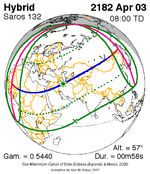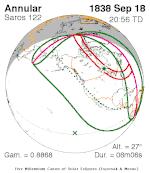

| Solar eclipse of November 12, 1947 | |
|---|---|
| Type of eclipse | |
| Nature | Annular |
| Gamma | 0.3743 |
| Magnitude | 0.965 |
| Maximum eclipse | |
| Duration | 239 s (3 min 59 s) |
| Coordinates | 3°00′N 117°24′W / 3°N 117.4°W / 3; -117.4 |
| Max. width of band | 135 km (84 mi) |
| Times (UTC) | |
| Greatest eclipse | 20:05:37 |
| References | |
| Saros | 132 (42 of 71) |
| Catalog # (SE5000) | 9393 |
An annular solar eclipse occurred at the Moon's descending node of orbit on Wednesday, November 12, 1947, with a magnitude of 0.965. A solar eclipse occurs when the Moon passes between Earth and the Sun, thereby totally or partly obscuring the image of the Sun for a viewer on Earth. An annular solar eclipse occurs when the Moon's apparent diameter is smaller than the Sun's, blocking most of the Sun's light and causing the Sun to look like an annulus (ring). An annular eclipse appears as a partial eclipse over a region of the Earth thousands of kilometres wide. Annularity was visible from the Pacific Ocean, Peru, Ecuador, Colombia and Brazil.
This eclipse is a member of a semester series. An eclipse in a semester series of solar eclipses repeats approximately every 177 days and 4 hours (a semester) at alternating nodes of the Moon's orbit.[1]
The partial solar eclipses on January 3, 1946 and June 29, 1946 occur in the previous lunar year eclipse set.
| Solar eclipse series sets from 1946 to 1949 | ||||||
|---|---|---|---|---|---|---|
| Ascending node | Descending node | |||||
| Saros | Map | Gamma | Saros | Map | Gamma | |
| 117 | May 30, 1946 Partial |
−1.0711 | 122 | November 23, 1946 Partial |
1.105 | |
| 127 | May 20, 1947 Total |
−0.3528 | 132 | November 12, 1947 Annular |
0.3743 | |
| 137 | May 9, 1948 Annular |
0.4133 | 142 | November 1, 1948 Total |
−0.3517 | |
| 147 | April 28, 1949 Partial |
1.2068 | 152 | October 21, 1949 Partial |
−1.027 | |
This eclipse is a part of Saros series 132, repeating every 18 years, 11 days, and containing 71 events. The series started with a partial solar eclipse on August 13, 1208. It contains annular eclipses from March 17, 1569 through March 12, 2146; hybrid eclipses on March 23, 2164 and April 3, 2182; and total eclipses from April 14, 2200 through June 19, 2308. The series ends at member 71 as a partial eclipse on September 25, 2470. Its eclipses are tabulated in three columns; every third eclipse in the same column is one exeligmos apart, so they all cast shadows over approximately the same parts of the Earth.
The longest duration of annularity was produced by member 25 at 6 minutes, 56 seconds on May 9, 1641, and the longest duration of totality will be produced by member 61 at 2 minutes, 14 seconds on June 8, 2290. All eclipses in this series occur at the Moon’s descending node of orbit.[2]
| Series members 34–56 occur between 1801 and 2200: | |||
|---|---|---|---|
| 34 | 35 | 36 | |
 August 17, 1803 |
 August 27, 1821 |
 September 7, 1839 | |
| 37 | 38 | 39 | |
 September 18, 1857 |
 September 29, 1875 |
 October 9, 1893 | |
| 40 | 41 | 42 | |
 October 22, 1911 |
 November 1, 1929 |
 November 12, 1947 | |
| 43 | 44 | 45 | |
 November 23, 1965 |
 December 4, 1983 |
 December 14, 2001 | |
| 46 | 47 | 48 | |
 December 26, 2019 |
 January 5, 2038 |
 January 16, 2056 | |
| 49 | 50 | 51 | |
 January 27, 2074 |
 February 7, 2092 |
 February 18, 2110 | |
| 52 | 53 | 54 | |
 March 1, 2128 |
 March 12, 2146 |
 March 23, 2164 | |
| 55 | 56 | ||
 April 3, 2182 |
 April 14, 2200 | ||
This eclipse is a part of a tritos cycle, repeating at alternating nodes every 135 synodic months (≈ 3986.63 days, or 11 years minus 1 month). Their appearance and longitude are irregular due to a lack of synchronization with the anomalistic month (period of perigee), but groupings of 3 tritos cycles (≈ 33 years minus 3 months) come close (≈ 434.044 anomalistic months), so eclipses are similar in these groupings.
| Series members between 1801 and 2100 | |||
|---|---|---|---|
 December 21, 1805 (Saros 119) |
 November 19, 1816 (Saros 120) |
 October 20, 1827 (Saros 121) | |
 September 18, 1838 (Saros 122) |
 August 18, 1849 (Saros 123) |
 July 18, 1860 (Saros 124) | |
 June 18, 1871 (Saros 125) |
 May 17, 1882 (Saros 126) |
 April 16, 1893 (Saros 127) | |
 March 17, 1904 (Saros 128) |
 February 14, 1915 (Saros 129) |
 January 14, 1926 (Saros 130) | |
 December 13, 1936 (Saros 131) |
 November 12, 1947 (Saros 132) |
 October 12, 1958 (Saros 133) | |
 September 11, 1969 (Saros 134) |
 August 10, 1980 (Saros 135) |
 July 11, 1991 (Saros 136) | |
 June 10, 2002 (Saros 137) |
 May 10, 2013 (Saros 138) |
 April 8, 2024 (Saros 139) | |
 March 9, 2035 (Saros 140) |
 February 5, 2046 (Saros 141) |
 January 5, 2057 (Saros 142) | |
 December 6, 2067 (Saros 143) |
 November 4, 2078 (Saros 144) |
 October 4, 2089 (Saros 145) | |
 September 4, 2100 (Saros 146) |
|||
In the 22nd century:
In the 23rd century:
The metonic series repeats eclipses every 19 years (6939.69 days), lasting about 5 cycles. Eclipses occur in nearly the same calendar date. In addition, the octon subseries repeats 1/5 of that or every 3.8 years (1387.94 days). All eclipses in this table occur at the Moon's descending node.
| 22 eclipse events between April 8, 1902 and August 31, 1989 | ||||
|---|---|---|---|---|
| April 7–8 | January 24–25 | November 12 | August 31–September 1 | June 19–20 |
| 108 | 110 | 112 | 114 | 116 |
 April 8, 1902 |
 August 31, 1913 |
 June 19, 1917 | ||
| 118 | 120 | 122 | 124 | 126 |
 April 8, 1921 |
 January 24, 1925 |
 November 12, 1928 |
 August 31, 1932 |
 June 19, 1936 |
| 128 | 130 | 132 | 134 | 136 |
 April 7, 1940 |
 January 25, 1944 |
 November 12, 1947 |
 September 1, 1951 |
 June 20, 1955 |
| 138 | 140 | 142 | 144 | 146 |
 April 8, 1959 |
 January 25, 1963 |
 November 12, 1966 |
 August 31, 1970 |
 June 20, 1974 |
| 148 | 150 | 152 | 154 | |
 April 7, 1978 |
 January 25, 1982 |
 November 12, 1985 |
 August 31, 1989 | |
This solar eclipse–related article is a stub. You can help Wikipedia by expanding it. |